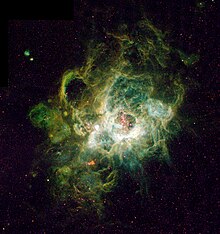Nebula: Difference between revisions
No edit summary |
Cecilkorik (talk | contribs) Undid revision 125906439 by 66.178.172.98 (talk) |
||
| Line 3: | Line 3: | ||
[[Image:Triangulum.nebula.full.jpg|thumb|The Triangulum Emission Nebula [[NGC 604]] lies in a spiral arm of [[Galaxy M33]], 2.9 million light-years from Earth. This nebula is a region in which stars are forming.]] |
[[Image:Triangulum.nebula.full.jpg|thumb|The Triangulum Emission Nebula [[NGC 604]] lies in a spiral arm of [[Galaxy M33]], 2.9 million light-years from Earth. This nebula is a region in which stars are forming.]] |
||
{{otheruses}} |
{{otheruses}} |
||
A '''nebula''' (from [[Latin]]: "mist" [http://www.etymonline.com/index.php?term=nebula]; pl. ''nebulae'' or ''nebulæ'', with [[Æ|ligature]]) is an [[interstellar cloud]] of dust, hydrogen gas and [[Plasma (physics)|plasma]]. Originally ''nebula'' was a general name for any extended [[astronomy|astronomical]] [[astronomical object|object]], including [[galaxy|galaxies]] beyond the [[Milky Way]] (some examples of the older usage survive; for example, the [[Andromeda Galaxy]] was referred to as the ''[[Andromeda (mythology)|Andromeda]] Nebula'' before galaxies were discovered by [[Edwin Hubble]]). Nebulae often form star-forming regions, such as in the [[Eagle Nebula]] |
A '''nebula''' (from [[Latin]]: "mist" [http://www.etymonline.com/index.php?term=nebula]; pl. ''nebulae'' or ''nebulæ'', with [[Æ|ligature]]) is an [[interstellar cloud]] of dust, hydrogen gas and [[Plasma (physics)|plasma]]. Originally ''nebula'' was a general name for any extended [[astronomy|astronomical]] [[astronomical object|object]], including [[galaxy|galaxies]] beyond the [[Milky Way]] (some examples of the older usage survive; for example, the [[Andromeda Galaxy]] was referred to as the ''[[Andromeda (mythology)|Andromeda]] Nebula'' before galaxies were discovered by [[Edwin Hubble]]). Nebulae often form star-forming regions, such as in the [[Eagle Nebula]]. This nebula is depicted in one of [[NASA]]'s most famous images, of the "Pillars of Creation". In these regions the formations of gas, dust and other materials 'clump' together to form larger masses, which attract further matter, and eventually will become big enough to form stars. The remaining materials are then believed to form planets, and other solar system objects. |
||
==The formation of nebulae== |
==The formation of nebulae== |
||
Revision as of 00:32, 14 May 2007
It has been suggested that Types of Nebulae be merged into this article. (Discuss) Proposed since April 2007. |

A nebula (from Latin: "mist" [1]; pl. nebulae or nebulæ, with ligature) is an interstellar cloud of dust, hydrogen gas and plasma. Originally nebula was a general name for any extended astronomical object, including galaxies beyond the Milky Way (some examples of the older usage survive; for example, the Andromeda Galaxy was referred to as the Andromeda Nebula before galaxies were discovered by Edwin Hubble). Nebulae often form star-forming regions, such as in the Eagle Nebula. This nebula is depicted in one of NASA's most famous images, of the "Pillars of Creation". In these regions the formations of gas, dust and other materials 'clump' together to form larger masses, which attract further matter, and eventually will become big enough to form stars. The remaining materials are then believed to form planets, and other solar system objects.
The formation of nebulae
Many nebulae form from the gravitational collapse of diffuse gas in the interstellar medium or ISM. As the material collapses under its own weight, massive stars may form in the centre and illuminate the surrounding gas allowing it to be observed. An example of this type of nebula is the Rosette Nebula or the Pelican Nebula.
Some nebulae are formed as the result of supernova explosions. One of the best examples of this is the Crab Nebula, in Taurus. It is the result of a recorded supernova in the year 1054. At the center of the nebula is a neutron star, created during the explosion.
Other nebulae may form as planetary nebulae. Again these are created near the end of a star's life; when a star with a mass of under 1.4 solar masses becomes a red giant. An outer layer of light hydrogen gas is ejected from the star as the fusion process slows, and the star becomes unable to sustain its entire mass. A nebula is made of luminiscent gases, rock and ash.
Glowing Nebula Beautiful wispy nebulas are made of glowing plasma.
Notable named nebulae
- Eagle Nebula
- Orion Nebula
- Hourglass Nebula
- Horsehead Nebula
- Rosette Nebula
- Ring Nebula
- Crab Nebula
- Cat's Eye Nebula
- Barnard's Loop
- Red Square Nebula
See also
- Emission nebula
- Reflection nebula
- Planetary nebula
- Solar nebula
- Timeline of the interstellar medium and intergalactic medium
- Messier object
